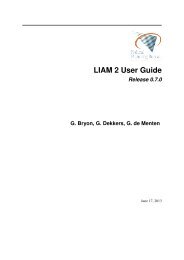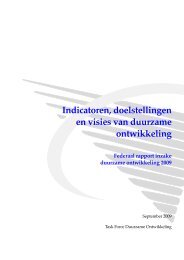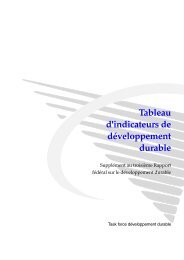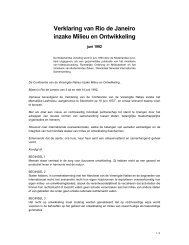long-term care use and supply in europe: projections for germany ...
long-term care use and supply in europe: projections for germany ...
long-term care use and supply in europe: projections for germany ...
Create successful ePaper yourself
Turn your PDF publications into a flip-book with our unique Google optimized e-Paper software.
LONG-TERM CARE USE AND SUPPLY IN EUROPE | 13<br />
Table 2.6 Predicted probabilities of <strong>in</strong>stitutionalisation <strong>in</strong> the Netherl<strong>and</strong>s (<strong>in</strong> percent)<br />
Pooled (males & females)<br />
Age groups 1-2 limitations 3+ limitations<br />
60-69 0.70 1.78<br />
(10.43) (43.78)<br />
70-74 1.35 3.22<br />
(17.65) (58.90)<br />
75-79 2.44 5.73<br />
(28.09) (72.35)<br />
80-84 7.97 11.30<br />
(45.02) (84.55)<br />
85+ 24.23 43.78<br />
(83.34) (92.41)<br />
Source: Calculation based on the estimates shown <strong>in</strong> Table 2.2<br />
(availability of <strong>in</strong><strong>for</strong>mal <strong>care</strong> =1, <strong>in</strong>come=1500, number of disorders=0).<br />
The estimated probability <strong>for</strong> people with dementia is shown <strong>in</strong> brackets.<br />
Conclusion<br />
Based on representative samples of elderly people, the estimated probability of <strong>in</strong>stitutionalisation<br />
differs between Spa<strong>in</strong> <strong>and</strong> the Netherl<strong>and</strong>s. First, this probability is significantly lower <strong>for</strong> women than<br />
<strong>for</strong> men <strong>in</strong> Spa<strong>in</strong>, which is not the case <strong>in</strong> the Netherl<strong>and</strong>s. It is not straight<strong>for</strong>ward to l<strong>in</strong>k this<br />
divergence with differences <strong>in</strong> LTC systems. On the contrary, the significant <strong>and</strong> negative impact of<br />
comorbidities <strong>in</strong> Spa<strong>in</strong> could be l<strong>in</strong>ked to differences <strong>in</strong> access to nurs<strong>in</strong>g homes among dependent<br />
people with health troubles.<br />
However, simulat<strong>in</strong>g predicted probabilities (Table 2.5 <strong>and</strong> Table 2.6) shows that age, number of<br />
functional limitations <strong>and</strong> dementia <strong>in</strong>crease the probability of <strong>in</strong>stitutionalisation <strong>in</strong> both countries. In<br />
addition, the availability of <strong>in</strong><strong>for</strong>mal <strong>care</strong> has a negative effect on <strong>in</strong>stitutionalisation <strong>in</strong> both countries.<br />
Nevertheless, dementia appears to play a stronger role on <strong>in</strong>stitutionalisation <strong>in</strong> the Netherl<strong>and</strong>s than <strong>in</strong><br />
Spa<strong>in</strong>, a result that may reflect differences <strong>in</strong> access to nurs<strong>in</strong>g homes. Un<strong>for</strong>tunately, the correlation<br />
between age <strong>and</strong> availability of <strong>in</strong><strong>for</strong>mal <strong>care</strong> <strong>and</strong> the imprecision of age data <strong>for</strong> Spa<strong>in</strong> make it difficult<br />
to compare the simulated results.<br />
Additionally, <strong>in</strong>stitutionalisation rates <strong>for</strong> Germany <strong>and</strong> <strong>for</strong> Pol<strong>and</strong> cannot be compared with each other<br />
or with estimates <strong>for</strong> Spa<strong>in</strong> <strong>and</strong> the Netherl<strong>and</strong>s beca<strong>use</strong> the adm<strong>in</strong>istrative data <strong>use</strong>d <strong>in</strong> Germany <strong>and</strong><br />
Pol<strong>and</strong> are not representative of the population with functional limitations. Indeed, elderly people<br />
suffer<strong>in</strong>g from <strong>in</strong>capacities <strong>and</strong> not enrolled <strong>in</strong> the <strong>long</strong> <strong>term</strong> <strong>care</strong> system are not, by def<strong>in</strong>ition,<br />
registered <strong>in</strong> adm<strong>in</strong>istrative data.<br />
References<br />
Böckerman, P., E. Johansson <strong>and</strong> S. Saarni (2010), Institutionalisation <strong>and</strong> quality of life <strong>for</strong> old age<br />
<strong>in</strong>dividuals <strong>in</strong> F<strong>in</strong>l<strong>and</strong>, ANCIEN (WP3), work<strong>in</strong>g paper.<br />
Gaugler, J.E., S. Duval, K.A Anderson <strong>and</strong> R.L Kane (2007), “Predict<strong>in</strong>g nurs<strong>in</strong>g home admission <strong>in</strong> the<br />
US: a meta-analysis”, BMC Geriatrics, 7: 13.<br />
Gol<strong>in</strong>owska, S. <strong>and</strong> A. Sowa (2011), Supply <strong>and</strong> utilisation of residential LTC services <strong>in</strong> Pol<strong>and</strong>,<br />
CASE, ANCIEN background paper.
















